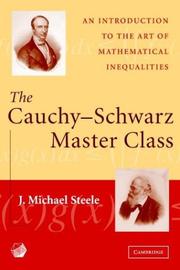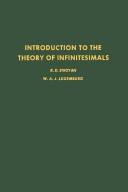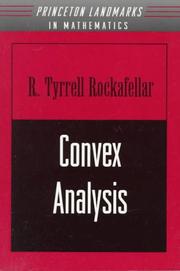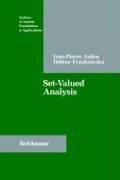| Listing 1 - 9 of 9 |
Sort by
|
Book
ISBN: 9033413752 Year: 1986 Publisher: Leuven Acco
Abstract | Keywords | Export | Availability | Bookmark
 Loading...
Loading...Choose an application
- Reference Manager
- EndNote
- RefWorks (Direct export to RefWorks)
Dit boek richt tot leraren secundair onderwijs en tot andere geïnteresseerden. Het boek bevat een vrij gedetailleerde uitwerking van de leerinhoud van een beperkte cursus analyse zoals die op het leerplan staat voor vele richtingen uit het secundair onderwijs met weinig uren wiskunde per week. Het accent ligt duidelijk op de begrippen afgeleide en bepaalde integraal. Het boek geeft een verantwoorde behandeling van deze begrippen, een paar stellingen en enkele eenvoudige rekenregels op een intuïtief en weinig formaal niveau. Er zijn ook een aantal uitgewerkte toepassingen van analyse in andere disciplines opgenomen. (Bron: covertekst)
517.1 --- #WWIS:AGGR --- 043051.jpg --- Wiskunde: didactiek: secundair onderwijs --- 517.1 Introduction to analysis --- Introduction to analysis --- Wiskunde --- Secundair onderwijs --- Didactiek --- Analyse --- Afgeleiden --- Integralen --- Continuïteit --- Differentialen --- Afgeleide --- Integraal (wiskunde) --- Differentiaalrekening

ISBN: 052154677X 0521837758 9780521837750 9780521546775 9780511817106 9780511211348 0511211341 9780511207761 051120776X 9780511213113 0511213115 9780511216718 0511216718 051181710X 1316099326 9781316099322 1107150434 9781107150430 9786613329264 6613329266 1283329263 9781283329262 0511214928 9780511214929 0511567065 9780511567063 Year: 2004 Publisher: Cambridge, UK New York
Abstract | Keywords | Export | Availability | Bookmark
 Loading...
Loading...Choose an application
- Reference Manager
- EndNote
- RefWorks (Direct export to RefWorks)
This lively, problem-oriented text, first published in 2004, is designed to coach readers toward mastery of the most fundamental mathematical inequalities. With the Cauchy-Schwarz inequality as the initial guide, the reader is led through a sequence of fascinating problems whose solutions are presented as they might have been discovered - either by one of history's famous mathematicians or by the reader. The problems emphasize beauty and surprise, but along the way readers will find systematic coverage of the geometry of squares, convexity, the ladder of power means, majorization, Schur convexity, exponential sums, and the inequalities of Hölder, Hilbert, and Hardy. The text is accessible to anyone who knows calculus and who cares about solving problems. It is well suited to self-study, directed study, or as a supplement to courses in analysis, probability, and combinatorics.
517.1 --- 517.1 Introduction to analysis --- Introduction to analysis --- Inégalités (Mathématiques) --- Inequalities (Mathematics). --- Inequalities (Mathematics) --- Processes, Infinite --- Mathematical analysis --- Processes, Infinite. --- Infinite processes --- Continued fractions --- Products, Infinite --- Series
Book
ISBN: 1283526336 0080957625 0444534075 9780444534071 0444106103 072042237X 9780720422375 Year: 1966 Publisher: Burlington : Elsevier Science,
Abstract | Keywords | Export | Availability | Bookmark
 Loading...
Loading...Choose an application
- Reference Manager
- EndNote
- RefWorks (Direct export to RefWorks)
Provability, Computability and Reflection
Logic, Symbolic and mathematical -- Periodicals. --- Logic, Symbolic and mathematical. --- 517.1 --- 517.1 Introduction to analysis --- Introduction to analysis --- Nonstandard mathematical analysis --- Logic, symbolic and mathematical --- Analyse mathématique non standard --- Nonstandard mathematical analysis.
Book
ISBN: 9065620788 9040712603 Year: 1996 Publisher: Delft Delftse Universitaire Pers
Abstract | Keywords | Export | Availability | Bookmark
 Loading...
Loading...Choose an application
- Reference Manager
- EndNote
- RefWorks (Direct export to RefWorks)
517.1 --- 517.1 Introduction to analysis --- Introduction to analysis --- 517 --- differentiaalrekenen --- wiskunde --- analyse --- Mathematical analysis --- 517.51 --- 517.51 Functions of a real variable. Real functions --- Functions of a real variable. Real functions

ISBN: 0126741506 9780126741506 9780080873886 008087388X 1281767611 9781281767615 9786611767617 6611767614 Year: 1976 Volume: 72 Publisher: New York : Academic Press,
Abstract | Keywords | Export | Availability | Bookmark
 Loading...
Loading...Choose an application
- Reference Manager
- EndNote
- RefWorks (Direct export to RefWorks)
Introduction to the Theory of infiniteseimals
Mathematical analysis --- Mathematics. --- Nonstandard mathematical analysis. --- Nonstandard mathematical analysis --- #TELE:d.d. Prof. A. J. J. Oosterlinck --- 517.1 --- 517.1 Introduction to analysis --- Introduction to analysis --- Analysis, Nonstandard mathematical --- Mathematical analysis, Nonstandard --- Non-standard analysis --- Nonstandard analysis --- Model theory --- Analyse mathématique non standard --- Math --- Science

ISBN: 0691015864 9780691015866 1400873177 9781400873173 0691080690 9780691080697 Year: 1997 Volume: 28 Publisher: Princeton, N.J.
Abstract | Keywords | Export | Availability | Bookmark
 Loading...
Loading...Choose an application
- Reference Manager
- EndNote
- RefWorks (Direct export to RefWorks)
Available for the first time in paperback, R. Tyrrell Rockafellar's classic study presents readers with a coherent branch of nonlinear mathematical analysis that is especially suited to the study of optimization problems. Rockafellar's theory differs from classical analysis in that differentiability assumptions are replaced by convexity assumptions. The topics treated in this volume include: systems of inequalities, the minimum or maximum of a convex function over a convex set, Lagrange multipliers, minimax theorems and duality, as well as basic results about the structure of convex sets and the continuity and differentiability of convex functions and saddle- functions. This book has firmly established a new and vital area not only for pure mathematics but also for applications to economics and engineering. A sound knowledge of linear algebra and introductory real analysis should provide readers with sufficient background for this book. There is also a guide for the reader who may be using the book as an introduction, indicating which parts are essential and which may be skipped on a first reading.
517.1 --- Convex domains --- Convex regions --- Convexity --- Calculus of variations --- Convex geometry --- Point set theory --- 517.1 Introduction to analysis --- Introduction to analysis --- Mathematical analysis. --- Convex domains. --- 517.1 Mathematical analysis --- Mathematical analysis --- Fonctions convexes --- Convex functions --- Nonlinear functional analysis --- Maxima and minima --- Analyse fonctionnelle non linéaire. --- Maximums et minimums. --- 516.08 --- 51 --- AA / International- internationaal --- Wiskunde --- Operational research. Game theory --- Functional analysis --- Analyse fonctionnelle non linéaire.
Book
ISBN: 9780817647070 0817647066 9780817647063 9786613438157 0817647074 1283438151 Year: 2007 Publisher: Boston, MA : Birkhäuser Boston : Imprint: Birkhäuser,
Abstract | Keywords | Export | Availability | Bookmark
 Loading...
Loading...Choose an application
- Reference Manager
- EndNote
- RefWorks (Direct export to RefWorks)
"This is an intermediate level text, with exercises, whose avowed purpose is to provide the science and engineering graduate student with an appropriate modern mathematical (analysis and algebra) background in a succinct, but nontrivial, manner.... [T]he book is quite thorough and can serve as a text, for self-study, or as a reference." —Mathematical Reviews Written for graduate and advanced undergraduate students in engineering and science, this classic book focuses primarily on set theory, algebra, and analysis. Useful as a course textbook, for self-study, or as a reference, the work is intended to: * provide readers with appropriate mathematical background for graduate study in engineering or science; * allow students in engineering or science to become familiar with a great deal of pertinent mathematics in a rapid and efficient manner without sacrificing rigor; * give readers a unified overview of applicable mathematics, enabling them to choose additional, advanced topical courses in mathematics more intelligently. Whereas these objectives for writing this book were certainly pertinent over twenty years ago when the work was first published, they are even more compelling now. Today’s graduate students in engineering or science are expected to be more knowledgeable and sophisticated in mathematics than students in the past. Moreover, today’s graduate students in engineering or science are expected to be familiar with a great deal of ancillary material (primarily in the computer science area), acquired in courses that did not even exist a couple of decades ago. The book is divided into three parts: set theory (Chapter 1), algebra (Chapters 2–4), and analysis (Chapters 5–7). The first two chapters deal with the fundamental concepts of sets, functions, relations and equivalence relations, and algebraic structures. Chapters 3 and 4 cover vector spaces and linear transformations, and finite-dimensional vector spaces and matrices. The last three chapters investigate metric spaces, normed and inner product spaces, and linear operators. Because of its flexible structure, Algebra and Analysis for Engineers and Scientists may be used either in a one- or two-semester course by deleting appropriate sections, taking into account the students’ backgrounds and interests. A generous number of exercises have been integrated into the text, and a section of references and notes is provided at the end of each chapter. Applications of algebra and analysis having a broad appeal are also featured, including topics dealing with ordinary differential equations, integral equations, applications of the contraction mapping principle, minimization of functionals, an example from optimal control, and estimation of random variables. Supplementary material for students and instructors is available at http://Michel.Herget.net.
Mathematics. --- Algebra. --- Functional Analysis. --- Engineering, general. --- Appl.Mathematics/Computational Methods of Engineering. --- Applications of Mathematics. --- Systems Theory, Control. --- Functional analysis. --- Systems theory. --- Engineering. --- Engineering mathematics. --- Mathématiques --- Algèbre --- Analyse fonctionnelle --- Ingénierie --- Mathématiques de l'ingénieur --- Algebra -- Textbooks. --- Electronic books. -- local. --- Mathematical analysis -- Textbooks. --- Mathematics --- Algebra --- Physical Sciences & Mathematics --- 512.5 --- 517.1 --- General algebra --- Introduction to analysis --- 517.1 Introduction to analysis --- 512.5 General algebra --- Mathematical analysis --- 517.1 Mathematical analysis --- Applied mathematics. --- System theory. --- Mathematical and Computational Engineering. --- Math --- Science --- Engineering --- Engineering analysis --- Construction --- Industrial arts --- Technology --- Functional calculus --- Calculus of variations --- Functional equations --- Integral equations --- Systems, Theory of --- Systems science --- Philosophy
Book
ISBN: 0387095012 9786611953720 1281953725 0387095020 3540095020 3540351949 3540095012 3540351973 9783540095019 9780387095011 9780387095028 Year: 1979 Volume: 718 Publisher: Berlin: Springer,
Abstract | Keywords | Export | Availability | Bookmark
 Loading...
Loading...Choose an application
- Reference Manager
- EndNote
- RefWorks (Direct export to RefWorks)
Over the last few decades, interest in white-collar crime has tended to take a back seat to "street" offenses in terms of theory and research. In response, and reflecting the rising general interest in business and middle/ upper class lawbreaking, The Criminology of White-Collar Crime brings the study of white-collar offending back into the criminology mainstream, analyzing why members of higher social strata resort to criminal activity and offering psychosocial, life course, methodological, and prevention perspectives. Leading scholars expand on the pioneering work of Edwin Sutherland, delving into the variables, situations, and cultural contexts that differentiate white-collar crime from more traditional criminal areas as well as into those that coincide with them. This book asks not only how the study of white-collar crime can enrich our understanding of crime and justice more generally, but also how criminological advances over the last few decades can enhance our understanding of white-collar criminality. To that end, the volume brings together a distinguished group of criminologists, drawn from leaders in the study of white-collar crime as well as important scholars that have advanced criminology more generally and that turn their attention to the problem of white-collar crime for this book.
Laser plasmas. --- Nonlinear theories. --- Plasma dynamics. --- White collar crimes --- Criminology --- Criminology, Penology & Juvenile Delinquency --- Social Welfare & Social Work --- Social Sciences --- White collar crimes. --- Criminology. --- Crime --- Occupational crimes --- Study and teaching --- Nonnumerical algorithms and problems: complexity of proof procedures; computations on discrete structures; geometrical problems and computations; pattern matching --See also {?681.3*E2-5}; {681.3*G2}; {?681.3*H2-3} --- Predicate calculus. --- 681.3*F22 Nonnumerical algorithms and problems: complexity of proof procedures; computations on discrete structures; geometrical problems and computations; pattern matching --See also {?681.3*E2-5}; {681.3*G2}; {?681.3*H2-3} --- Criminology and Criminal Justice. --- Criminology and Criminal Justice, general. --- 517.1 --- 681.3*F22 --- 517.1 Introduction to analysis --- Introduction to analysis --- Plasma physics --- Mathematical logic --- Social sciences --- Criminals --- Computational complexity. --- Logic, Symbolic and mathematical --- Automatic theorem proving --- Logique mathématique --- Théorèmes --- Démonstration automatique --- Computational complexity --- Predicate calculus

ISBN: 0817634789 081764847X 9786612036200 1282036203 0817648488 9780817634780 9780817648473 Year: 1990 Volume: 2 Publisher: Boston (Mass.): Birkhäuser,
Abstract | Keywords | Export | Availability | Bookmark
 Loading...
Loading...Choose an application
- Reference Manager
- EndNote
- RefWorks (Direct export to RefWorks)
"An elegantly written, introductory overview of the field, with a near perfect choice of what to include and what not, enlivened in places by historical tidbits and made eminently readable throughout by crisp language. It has succeeded in doing the near-impossible—it has made a subject which is generally inhospitable to nonspecialists because of its ‘family jargon’ appear nonintimidating even to a beginning graduate student." —The Journal of the Indian Institute of Science "The book under review gives a comprehensive treatment of basically everything in mathematics that can be named multivalued/set-valued analysis. It includes…results with many historical comments giving the reader a sound perspective to look at the subject…The book is highly recommended for mathematicians and graduate students who will find here a very comprehensive treatment of set-valued analysis." —Mathematical Reviews "I recommend this book as one to dig into with considerable pleasure when one already knows the subject...'Set-Valued Analysis’ goes a long way toward providing a much needed basic resource on the subject." —Bulletin of the American Mathematical Society "This book provides a thorough introduction to multivalued or set-valued analysis...Examples in many branches of mathematics, given in the introduction, prevail [upon] the reader the indispensability [of dealing] with sequences of sets and set-valued maps…The style is lively and vigorous, the relevant historical comments and suggestive overviews increase the interest for this work...Graduate students and mathematicians of every persuasion will welcome this unparalleled guide to set-valued analysis." —Zentralblatt Math.
Set-valued maps --- Mathematics. --- Mathematical analysis. --- Analysis (Mathematics). --- Applied mathematics. --- Engineering mathematics. --- Game theory. --- System theory. --- Control engineering. --- Robotics. --- Mechatronics. --- Systems Theory, Control. --- Control, Robotics, Mechatronics. --- Analysis. --- Applications of Mathematics. --- Game Theory, Economics, Social and Behav. Sciences. --- Systems theory. --- Global analysis (Mathematics). --- Math --- Science --- Analysis, Global (Mathematics) --- Differential topology --- Functions of complex variables --- Geometry, Algebraic --- Games, Theory of --- Theory of games --- Mathematical models --- Mathematics --- 517.1 Mathematical analysis --- Mathematical analysis --- Mechanical engineering --- Microelectronics --- Microelectromechanical systems --- Engineering --- Engineering analysis --- Systems, Theory of --- Systems science --- Automation --- Machine theory --- Control engineering --- Control equipment --- Control theory --- Engineering instruments --- Programmable controllers --- Philosophy --- 517.1 --- 517.1 Introduction to analysis --- Introduction to analysis --- Many-valued mappings --- Mappings, Point-to-set --- Maps, Set-valued --- Multi-valued mappings --- Multivalued mappings --- Point-to-set mappings --- Mappings (Mathematics) --- Selection theorems --- Automatic control.
| Listing 1 - 9 of 9 |
Sort by
|

 Search
Search Feedback
Feedback About UniCat
About UniCat  Help
Help News
News